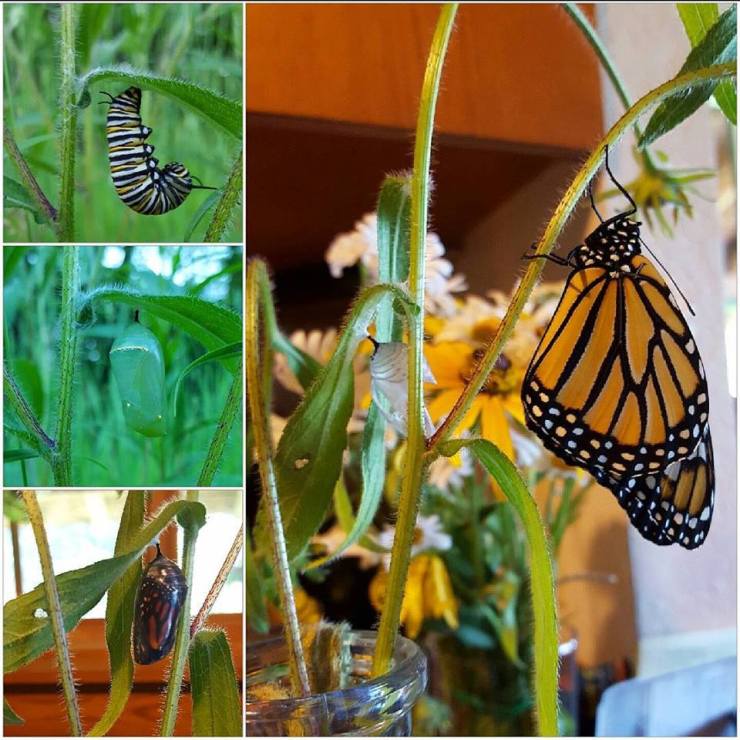
Monarch butterflies, some of the most stunning, brightly colored, eye-catching insects, could not be performing a disappearing act, could they? Monarch butterflies used to be seen in swarms of thousands flying overhead, a bright orange cloud migrating from Canada to Mexico for the winter. As a child, I know that I was not alone in anxiously awaiting their arrival to watch the caterpillars grow and emerge from their cocoons as beautiful orange and black butterflies. In recent years, the population of these migratory insects has declined rapidly in response to habitat loss—this species, in fact, is beginning to disappear.
Each year, monarchs fly from Mexico to Canada and the northern states around the end of March, and spend the summer mating and reproducing. Near the end of August and September, they complete their astounding yearly 3,000 mile journey by migrating to Mexico. This long expedition usually comprises four generations of monarchs, as the butterflies reproduce and die through the trip. The journey itself seems dangerous, and difficult enough as it is—of course there are going to be a few monarch casualties. So what’s the big fuss?
According to National Geographic, the monarch butterfly population has declined by 90% in the past twenty years. In addition, last year resulted in the lowest monarch population count ever recorded (Conant, Eve). This population decrease is very dangerous to the survival of this population, and they are close to being placed on the threatened species list. Normally, when monarchs migrate to Mexico and flock to the forest canopies, they cover an area of 50 acres. A few years ago, they were only spotted on less than two acres. This is the lowest range ever recorded, sparking the interest of conservationists around the country wondering where the group that normally flocks to the other 48 acres has gone. Although a lot of these questions have been answered, it is going to take the education and teamwork of our nation to bring the population of this astounding insect back to normal levels.
During President Obama’s presidency, he worked with the leaders of Canada and Mexico in an effort to preserve monarchs, bees, and other pollinating insects. Although our nation is already working towards change and the conservation of monarch butterflies, there are things that you can do to assist in this essential mission.
1. The first step in facilitating change is being educated enough to educate others on what is going on in the world of the monarch butterflies.
The butterfly population has declined in response to illegal logging and droughts in Mexico, destroying the forest canopies where the monarchs reside for a large part of the year. In addition, the monarch caterpillar’s single food source, a leafy green plant called milkweed, is disappearing very rapidly due to various sources such as herbicides. Without milkweed, the monarchs cannot lay their eggs directly onto the leaves that the larva eat, and the larva can’t survive in order to reproduce again. Milkweed also provides protection for monarch caterpillars and butterflies. By eating this plant, the larva ingest a toxin that make them toxic and bitter tasting to predators. This toxin is also carried onto the butterflies, making them seem like an unappetizing meal to a passing bird. Clearly, milkweed is essential to the survival of monarch butterflies, and certain herbicides are killing off this plant, harming the monarch population.
2. The next step in creating a positive change for this population is to take action: plant milkweed and eliminate pesticides!
Clearly, one course of action is to plant more milkweed so that the insect’s larva can thrive, and eventually reproduce. Milkweed seeds are available to the public, and every effort, however small, is beneficial. If you are someone who sprays herbicides on crops, it is recommended that they are sprayed earlier in the season to avoid the time that the milkweed is flowering and is more susceptible to being killed.
3. Lastly, you can work with people across the nation to help tag monarch butterflies and report sightings.
Although researchers work very hard to track their location and migration patterns, it is helpful to have citizen scientists watching out for these stunning monarch butterflies by tagging the insects, reporting migration sightings, and monitoring caterpillar presence on milkweed plants.
Although the monarch butterfly population is decreasing to dangerous levels, if our nation works together to educate others on the need for conservation, and takes action to save this species, we hope to see those orange clouds in the sky once again, the sign of a classic monarch migration. Hopefully we can accomplish this before the monarchs play the last card of their disappearing act…and actually disappear.
Source:
Conant, Eve. “As Dwindling Monarch Butterflies Make Their Migration, Feds Try to Save Them.” National Geographic. National Geographic Magazine, 10 Oct. 2014. Web.

Leave a comment